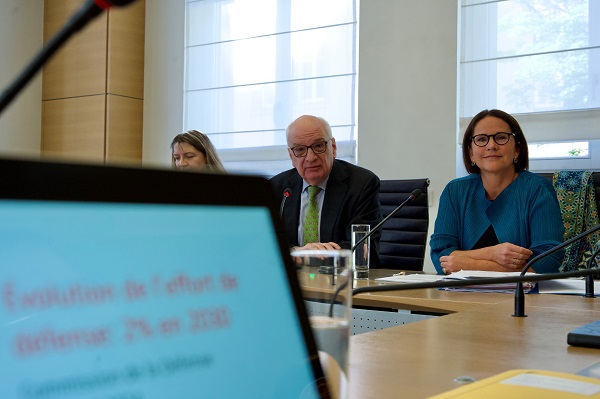 (L-R) Guy Arendt, President of the parliamentary committee of defence; Yuriko Backes, Luxembourg's Minister of Defence;
Credit: MAE
(L-R) Guy Arendt, President of the parliamentary committee of defence; Yuriko Backes, Luxembourg's Minister of Defence;
Credit: MAE
The Directorate of Defence has reported that Luxembourg's Minister of Defence, Yuriko Backes, presented the evolution of the Grand Duchy's defence effort to the competent committees of the Chamber of Deputies (Luxembourg's parliament) on Wednesday 12 June 2024.
Minister Backes presented the efforts being made to raise defence spending to 2% of gross national income (GNI) by 2030. This corresponds, according to current estimates, to an increase from €696 million in 2024 to approximately €1.464 billion in 2030.
"This plan is an investment in our defence and our security, it is the guarantor of solidarity and the credibility of our contribution to the collective effort. It sets the framework for defence development until the end of the decade, and beyond," stated Minister Backes, adding: "The need to revitalise the deterrence and defence capacity of NATO and within the European Union has become a priority in a world prey to growing tensions, which call into question the multilateral order, and especially in the face of Russian aggression against Ukraine, which constitutes an unprecedented threat to European security and stability since the end of the Second World War."
As reported by the Defence Directorate, this strengthening of NATO's posture and the implementation of collective deterrence and defence plans require an increase in Allies' investments in their defence and the development of capabilities which are deemed essential. As such, at the NATO summit in Vilnius in 2023, the Allies committed to devoting at least 2% of GDP to defence. For Luxembourg, due to its specific situation, GNI serves as the basis of calculation. The Luxembourg government has set itself the objective of achieving defence spending of 2% of GNI in the medium term, namely by 2030.
Chosen trajectory: 2% of GNI by 2030
The new trajectory, adopted by the Council of Government (cabinet) on 5 June 2024, is as follows: an estimated €780 million (1.32% of GNI) dedicated to defence in 2025; €882 million (1.43%) in 2026; €993 million (1.55%) in 2027; €1.106 billion (1.66%) in 2028; €1.277 billion (1.83%) in 2029; €1.461 billion (2%) in 2030.
The following project avenues, linked to the coalition agreement, were selected in the military domain:
- Land: establishment of the binational Belgian-Luxembourg mid-range combat reconnaissance battalion, notably munitions, missiles, simulation means and combat vehicles;
- Space: development of space capabilities, particularly in the areas of satellite communications and Space Situational Awareness (SSA);
- Air: development of Integrated Air and Missile Defence (IAMD) capabilities, financial support for the NATO AWACS aircraft replacement programme (initial Alliance Future Surveillance and Control - iAFSC), airport infrastructure at Luxembourg Airport;
- Cyber: strengthening the resilience of national IT infrastructures;
- Medical: cooperation with the Ministry of Health and national hospitals to strengthen health resilience, strengthening strategic medical evacuation capacities, training;
- Infrastructure: establishment of a multimodal logistics hub (Multimodal Military Hub - M3H) in Sanem (extension of the Warehouses Service Agency - WSA) as part of the binational battalion.
Emphasis will be placed on the "economic and societal return" perspective when developing future projects. This will be done particularly through the creation of an interministerial working group to adopt a shared whole-of-government approach with the objective of integrating Luxembourg companies into defence projects and promoting Luxembourg companies at EU and NATO level.
Military support for Ukraine
From 2025, military support for Ukraine will be included in a specific non-limitative budget line. This way of proceeding has several advantages, according to the Defence Directorate: more funds available for defence projects and better budget planning; more flexibility for the government to decide each year on military support for Ukraine, depending on the security situation and developments on the ground; this support, while counting towards the defence effort, will no longer be subject to the limits of the fixed trajectory and will therefore no longer depend on unpredictable developments in GNI.
The actual expenditure communicated to NATO will include the amount of military support for Ukraine. With this addition, the "real" defence effort declared to NATO is expected to exceed the established trajectory.
Defence spending by other ministries
The Defence Directorate noted that defence spending, according to NATO, is payments made by a national government for the express purpose of meeting the needs of the country's armed forces or those of Allied countries.
As such, spending by other ministries is also considered part of Luxembourg's defence effort. Currently, this concerns in particular the expenditure of the Public Building Administration for the benefit of defence (e.g. renovation projects linked to the Härebierg military centre and military infrastructures in Bleesdall and Waldhof) and 1.6% of the Grand Ducal Police's expenditure. From 2024 and 2025, this will include, among other things, interest on state loans (defence's share of the overall budget) as well as social benefits for army personnel.
Modalities and challenges
The Defence Directorate added that Luxembourg's military credibility will largely depend on its ability to fulfil the current and future capability objectives assigned to it within the framework of the NATO Defence Planning Process (NDPP). Luxembourg's next military objectives, resulting from the next cycle of this process which aims to preserve the military advantage of the Alliance over identified possible adversaries and competitors, will not be known until mid-2025. As such, the current trajectory priorities may need to be reassessed following the adoption of the new capability objectives.
On Thursday 13 and Friday 14 June 2024, Minister Backes will present the trajectory and avenues of selected projects to her counterparts during the meeting of NATO Defence Ministers in Brussels, Belgium.








